Makoto Shinkai’s latest blockbuster anime film, Suzume No Tojimari, could be the acclaimed director’s best film yet. Suzume No Tojimari (literally Suzume’s door locking or Suzume’s door lock in English) is a fantastical film set in present-day Japan. The film follows a high-school girl named Suzume as she travels around Japan sealing away a mysterious creature that threatens the fate of the world.
With this film, Shinkai has shown just how much he’s grown as a writer and director. In this review of Suzume No Tojimari, I’ll explain which aspects of this film surpass Your Name and Weathering With You, as well as cover areas where the film falls short. Without a doubt, after reading this review, it’ll be even harder to wait for the film’s international release scheduled for early 2023. And after watching Suzume No Tojimari yourself, you’ll learn just which doors in life need to stay closed, and which should be confronted head on.
Suzume No Tojimari Review Table of Contents:
- Story
- Setting
- Real-world allusions
- Pacing
- Music
- Graphics / Animation
- Voice Acting
- Final Verdict
SPOILER WARNING: This review will have minor spoilers of the film’s story, which are unavoidable in most reviews. But going further than that, there are some amazing allusions in this film that Shinkai pulls off and I really need to talk about them to explain the greatness this film has to offer. So please be warned, this review will have more spoilers than your average review and you should stop reading here if you don’t want to spoil the story for yourself.
Suzume No Tojimari Story Review
The film begins with Suzume dreaming about a traumatic event from her childhood. She is lost outside on a snowy day. Alone, she clutches a yellow chair and cries out for her mother. She sees two mysterious figures and then wakes up.
On her way to her high school, she crosses paths with a handsome young man who looks familiar to her. The man stops and asks her if she’s seen a door nearby. Since that is a super weird thing to ask a stranger, Suzume is confused and doesn’t answer. He then asks if there are any abandoned buildings or areas nearby and Suzume says there is an old onsen area that has been condemned and points him in that direction.
Intrigued, she skips school and seeks out the man in the abandoned onsen. There, she sees a mysterious door in the middle of the onsen ruins, and the handsome man trying his best to close the door. From the door pours out a mysterious red-black smoke of incredible force causing earthquakes and other phenomena.
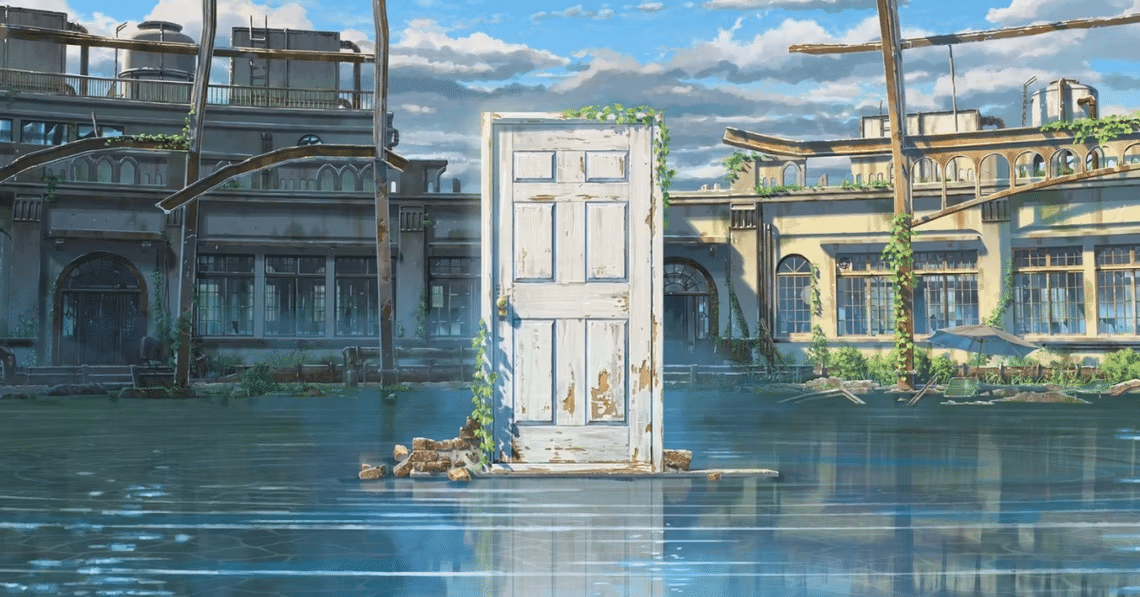
Without thinking, Suzume springs into action to help the man close and seal the door. The man, named Sota, explains that all around Japan these mysterious doors spring up in abandoned buildings. The doors are portals to another dimension where a being he calls Mimizu (earthworm) exists and if the Mimizu is able to come through the door, it could spell the end of the world.
Every time a Mimizu is about to emerge, there is an earthquake which warns them of its coming and they have just a short time after to seal the door.
Sota says for hundreds of years his family has been tasked with the responsibility of finding the doors and sealing them. Suzume offers to help him seal the doors, and because of various circumstances, Sota reluctantly accepts her help.
Setting
The first door appears in Suzume’s inaka hometown in Kyushu. After that, Suzume and Sota travel to the next door that appears somewhere in Ehime prefecture, then Kobe, Tokyo, and finally, Miyagi prefecture.
So the film takes us all the way from the south of Japan in the Kyushu region to the northern prefecture of Miyagi in the Tohoku region.
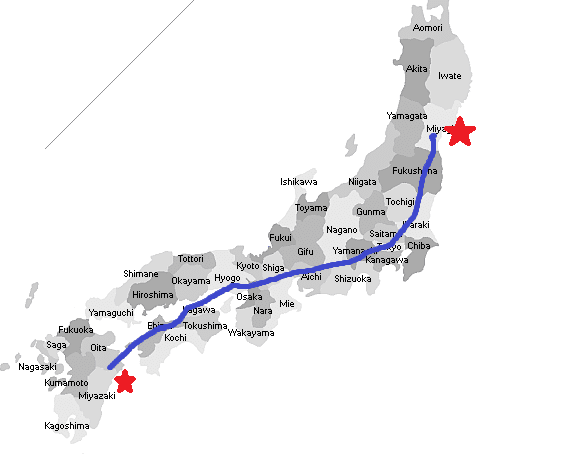
I really liked how Shinkai pretty much took us all over Japan and it wasn’t just to give us a tour of his country. In the story, the interdimensional doors only appear in places that people have abandoned. So, in a way, Shinkai is showing us that there are abandoned areas everywhere in Japan, regardless of prefecture or city. When we learn why those areas are abandoned it makes the story that much more powerful, especially for those of us who live in Japan.
Shinkai Bridges the Gap Between Fantasy and Reality
One of the biggest things that separates Shinkai from Studio Ghibli Director Hayao Miyazaki is their settings and the world their stories are grounded in. Most of Miyazaki’s works take place in a fantasy world incredibly foreign from our own, like the spirit-world onsen in Spirited Away or the barren post-apocalyptic deserts of Nausicaa. Miyazaki transports us to worlds we’ve never dreamed of filled with characters we could never imagine and we love him for it.
On the other hand, Shinkai’s biggest films (Your Name, Weathering With You, 5 CM Per Second) all take place in present-day Japan, usually largely in Tokyo. Shinkai’s films usually ground us in the real world and show us cool fantastical things that happen in our real world which makes them more powerful.
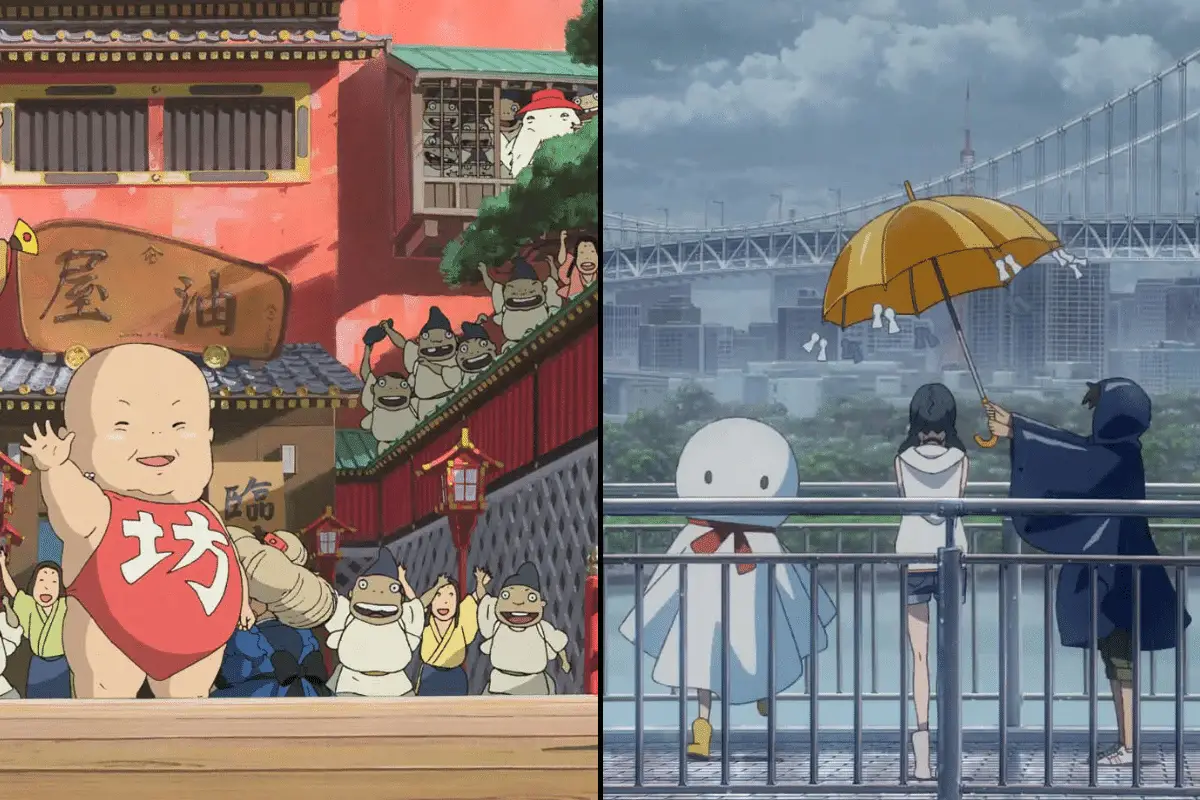
Your Name made us wonder how awesome it would be to trade places with someone for a day, and Weathering With You had us all wishing we could control the rain.
With Suzume No Tojimari, Shinkai has found a way to bridge the gap between his film style and Miyazaki’s. While it does take place in present-day Japan, there is also the other dimension where the Mimizu reside and we see both the real world and this other world in the film.
Real-World Allusions
Because of how Shinkai bridges that gap, the real-world allusions are all the more powerful. And the real-world allusion Shinkai uses in Suzume No Tojimari is one all Japanese know all to well: earthquakes.
In the film, earthquakes warn Suzume and Sota that a Mimizu is soon to appear, and bring with it a calamity that could end the world.
In the real world, earthquakes are themselves the calamity that has caused horrific destruction throughout the country. For those who lost loved ones in some of Japan’s major earthquakes, the earthquakes themselves are the calamity that ends their world.

This is not a hidden allusion that I’m interpreting my way. This is a direct allusion that slaps us in the face when we learn that Suzume lost her mother in the great Tohoku earthquake of March 11, 2011. We learn that Suzume’s hometown is in Miyagi, an area that was largely devastated by the tsunami that followed the earthquake on that terrible day.
With these allusions, Shinkai further bridges the gap between fantasy and reality itself. We realize that all those abandoned places that Suzume and Sota travel to were abandoned because they were damaged by earthquakes and too costly to repair.
Suzume and Sota needs to travel to those abandoned places and seal a door that pops up within them.
In life, there are doors we all must close in order to move forward and grow. Sometimes those doors are places in our past we have to let go of. Sometimes those doors are traumas of our past weighing us down.
For those affected by the Tohoku earthquake, there were many places they had to leave behind and doors they had to close. And Shinkai isn’t saying that we have to forget the past, rather he shows that we have to confront it and move forward.
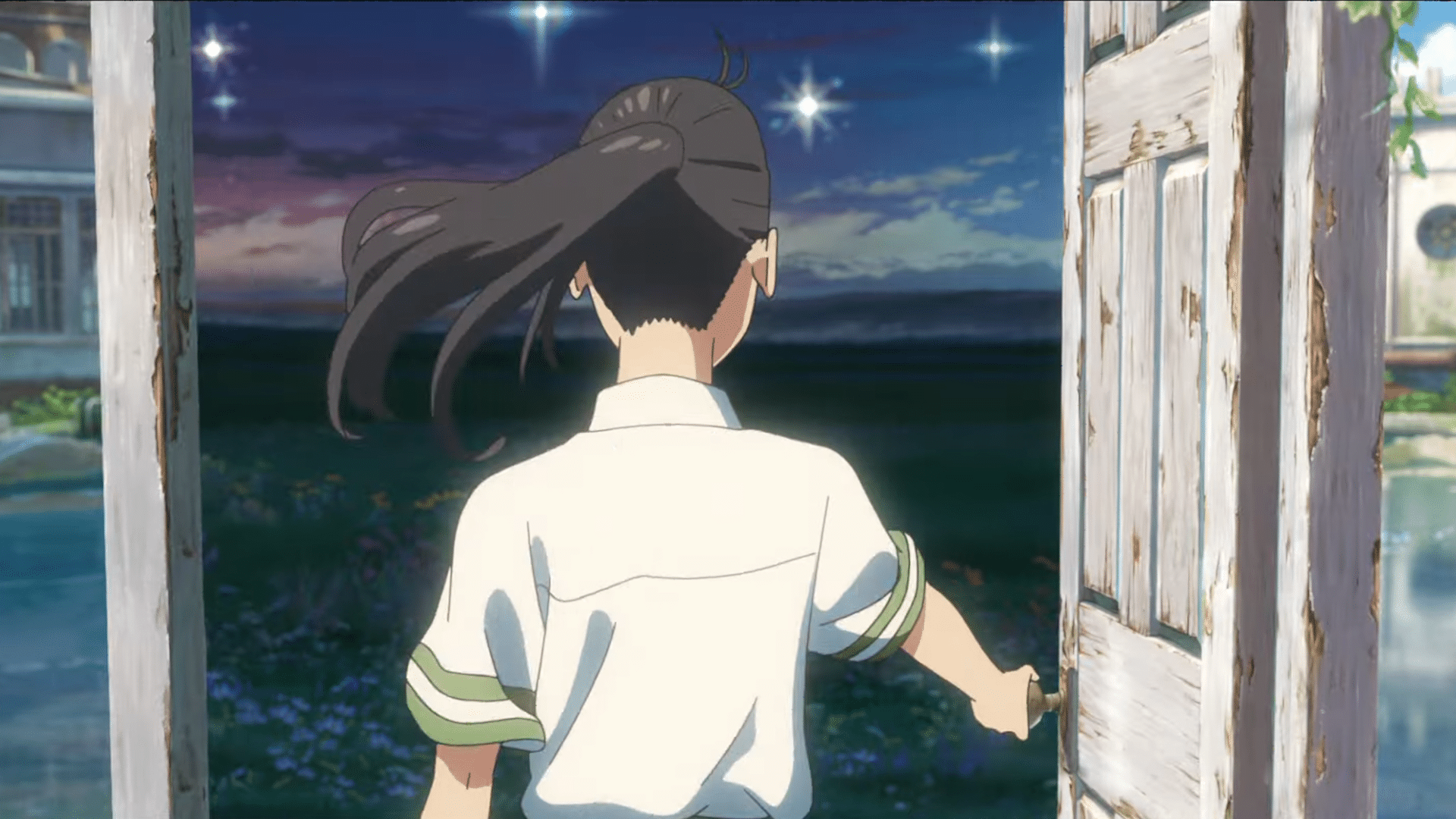
This is beautifully illustrated in the final scene and the final door. Throughout the film, whenever Suzume and Sota would seal a door, they’d always say お返しします (okaeshishimasu) “I return you” or “I send you back”. After that, the door disappears. The connotation there is that the door doesn’t belong there and needs to go back to where it came from, meaning that is isn’t part of this world.
However, at the final door, after Suzume realizes what happened in her past, confronts her childhood self, and overcomes the traumatic loss of her mother, she doesn’t say “I send you back”. Instead she says 行ってきます (itekimasu) in a light, loving tone.
This is a phrase all Japanese say when they leave home in the morning. When a father goes off to work, he puts on his shoes, and before exiting the house he says itekimasu. Before a child heads off to school, they shout itekimasu! to their mother.
Thus, that final door that leads to the most traumatic event in Suzume’s life, is not treated as something she needs to send away. Instead, she treats it as something important to her life, something that’s a part of her, and something she no longer has to fight or forget.
Pacing
The film is very fast-paced and it’s amazing how CoMix Wave was able to cram such an epic story into 2 hours and 2 minutes of runtime.
There honestly isn’t a single wasted beat, and the film doesn’t drag on in any scene. As soon as we get acclimated to the area Suzume and Sota travel to, they learn of their next destination and on we go.
Where The Story Falls Short: Romance
Throughout my review of Suzume No Tojimari, my only criticism is the romance aspect of the film. Honestly, the powerful story of the film is enough to standalone without having to ship the two main characters.
All of Shinkai’s past films were built upon the love between the two main characters and it almost feels like the romance between Suzume and Sota was forced just to meet the expectation of fans of Shinkai’s previous films. Sure Sota is a handsome guy, but they meet for a short period of time before Sota is turned into a chair.
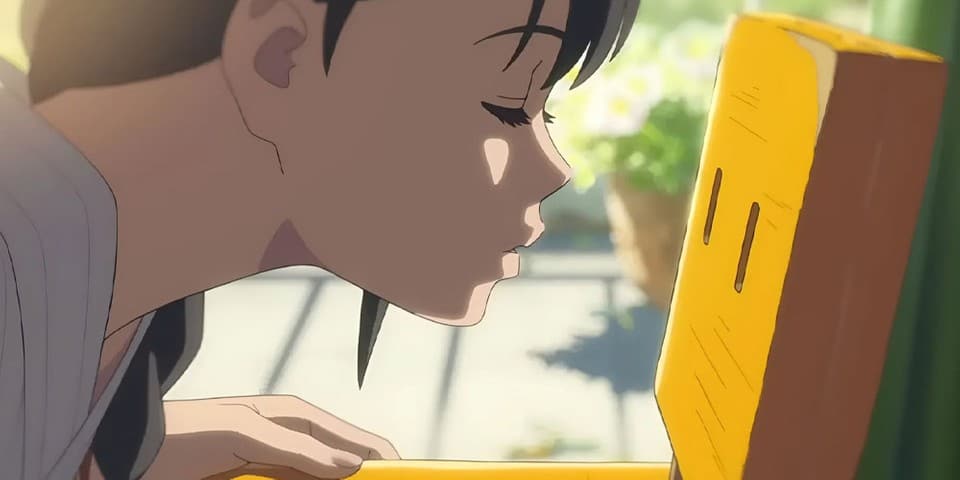
The two didn’t overcome a trauma or foster a relationship long enough to fall in love. However, Suzume seems to already be in love with Sota in the second act of the film, after knowing him for all of 30 minutes and then carrying him around as a chair for the rest of the day.
By the end of the film (as seen in the movie trailer) Suzume is ready to sacrifice her life for him, and I don’t really know why. I might be alone in this opinion, and others have said that Suzume feels like she’s known her whole life Sota because she meets him in her childhood (I won’t tell you how because that’ll spoil the film even more), but I’m sorry, I’m just not buying it.
Suzume No Tojimasu Soundtrack Review
Like Kimi No Na Wa and Tenki No Ko, the soundtrack for Suzume No Tojimari has again been composed by Radwimps. This time Radwimps has worked together with Kazuma Jinnouchi (composer of Halo 5: Guardians and Metal Gear Solid 4 Guns of the Patriots) to compose the music for the film.
What I liked most about the music for Suzume No Tojimari was that it didn’t overpower the film. With Your Name Radwimps songs sometimes drove the story forward and overpowered even the dialogue being said in some scenes. I can remember the montage in Your Name when Zen Zen Zense played, but I can barely remember the dialogue. I don’t think that was necessarily a bad thing, as I LOVE the Kimi No Na Wa soundtrack.
However, I like the change Shinkai, Radwimps, and Jinoouchi made with the soundtrack for Suzume No Tojimari. The songs and the score complement the scenes and the dialogue, rather than overpowering them or take the spotlight. Take a listen below:
Graphics / Animation
While I write this review of Suzume No Tojimari, I’m constantly thinking back to Shinkai’s past works and how he’s used what he’s learned in the past to improve each film.
In his past works, Garden of Words and Weathering With You, Shinkai experimented with how to present the weather in anime. You can see hyper-realistic illustrations of rain in Garden of Words, and in Weathering With You Shinkai explored how weather alone can express the emotions of characters and even drive the plot forward.
Suzume No Tojimari is centered on natural phenomena and Shinkai uses that as a plot device. In the film, everytime Suzume and Sota finish sealing a door, there is a sudden burst of rain, signifying they completed the task.
Even just in the poster of the film, you can see how beautifully Shinkai and CoMix Wave present water throughout the film.
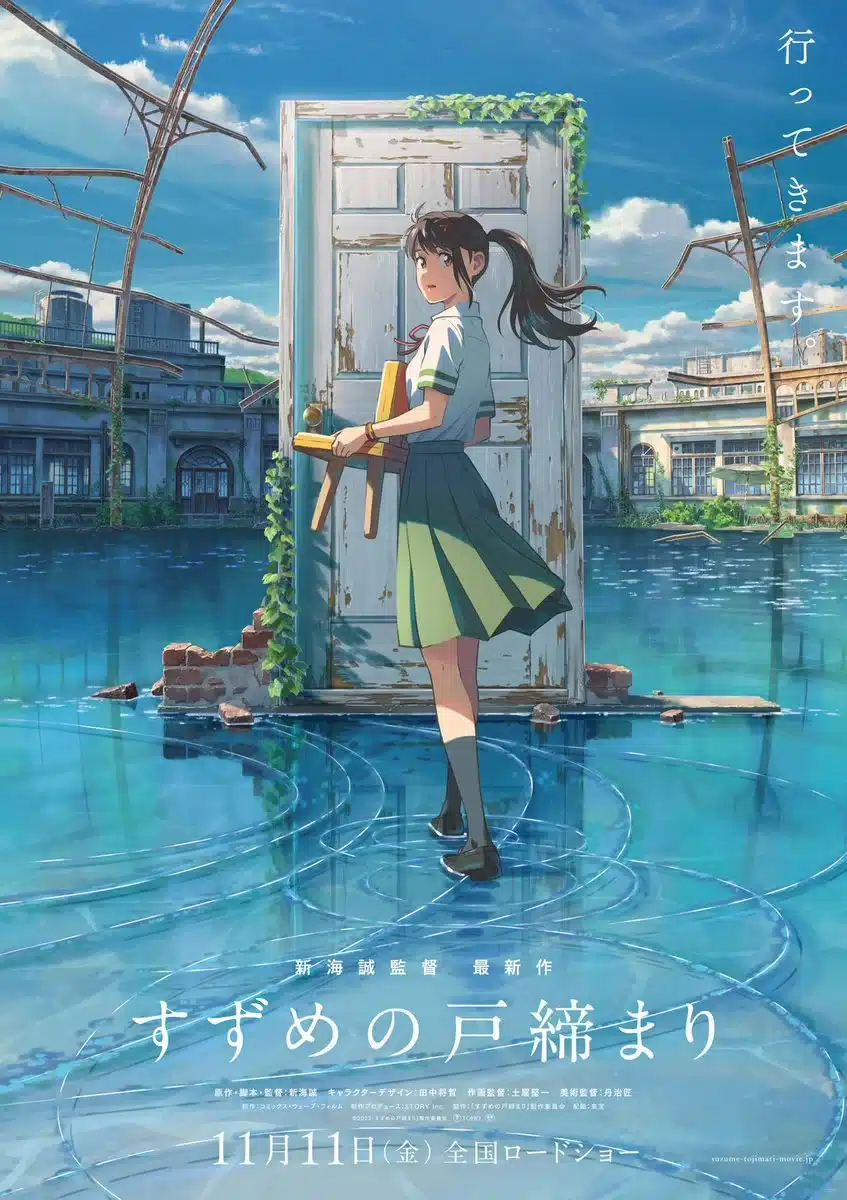
Another feat to note is how well they pulled off the anthropomorphization of the chair. In the film, as you learned in the trailer, Sota is turned into a chair. This presented an important problem for Shinkai: how do you make a chair walk? All I’ll say is they pulled it off in spectacular fashion.
Voice Acting
Suzume No Tojimari stars Nanoka Hara as Suzume and Hokuto Matsumura as Sota. Hara has an impressive filmography of all live-action shows and films. This being her first gig as a voice actor for an anime, her performance is amazing and heartfelt all throughout the film.

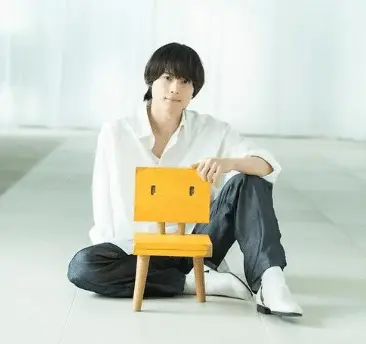
Matsumura is better known in Japan for his singing ability as a member of the JPOP idol group SixTONES. Seeing that he is a singer first and an actor second and this too is his first anime film, I have nothing but respect for his performance. It’s important to note that throughout most of the film, Matsumura as Sota is shown on screen as a yellow chair. To be able to convey emotion through your voice without any visual cues (a chair can’t smile) is a respectable accomplishment for any actor.
Suzume No Tojimari Review Final Verdict: 9/10
Stellar voice acting, check. Breathtaking graphics and animation, check. Hauntingly beautiful soundtrack, check. Heartwrenching, tearjerking, deep and grounded narrative, CHECK CHECK CHECK.
Suzume No Tojimari has all the elements that could skyrocket it to the top of Shinkai’s filmography and I wouldn’t think twice if someone told me it was his best film yet.
It’s going to be hard for any Shinkai film to get out of Your Name’s shadow. After all, that was the film that put Shinkai on the map and made him a household name for anime fans all over the world.
On paper, Suzume No Tojimari is Shinkai’s best film, hands down. The narrative is stronger, deeper, and holds up way better than Your Name does. Moreover, the story of Suzume No Tojimari is real. It matters to Japan and it can even serve as an artistic illustrative piece on how the great Tohoku earthquake devastated the country and affected its people.
The music was beautiful and well-balanced, not overpowering any scene. The animation by CoMix Wave was beautiful as always, and the voice actors did a splendid job.
On paper, it’s better. But I’m sure many fans will still say Your Name reigns supreme, and that’s fine. It’s hard for me to ever replace the spot Your Name holds in my heart too.
However, I have to admit that after looking at it both objectively and subjectively, Suzume No Tojimari is Shinkai’s best film, built upon a powerful narrative and well-rounded characters.
You don’t have to agree with me. However, I’m sure that after you watch Suzume’s Doorlocking, you’ll agree that this is one story that should never be sealed away or forgotten, but rather, watched and enjoyed for decades to come.
I hope you enjoyed this Suzume No Tojimari review! Let me know what you think about the film in the comments below.

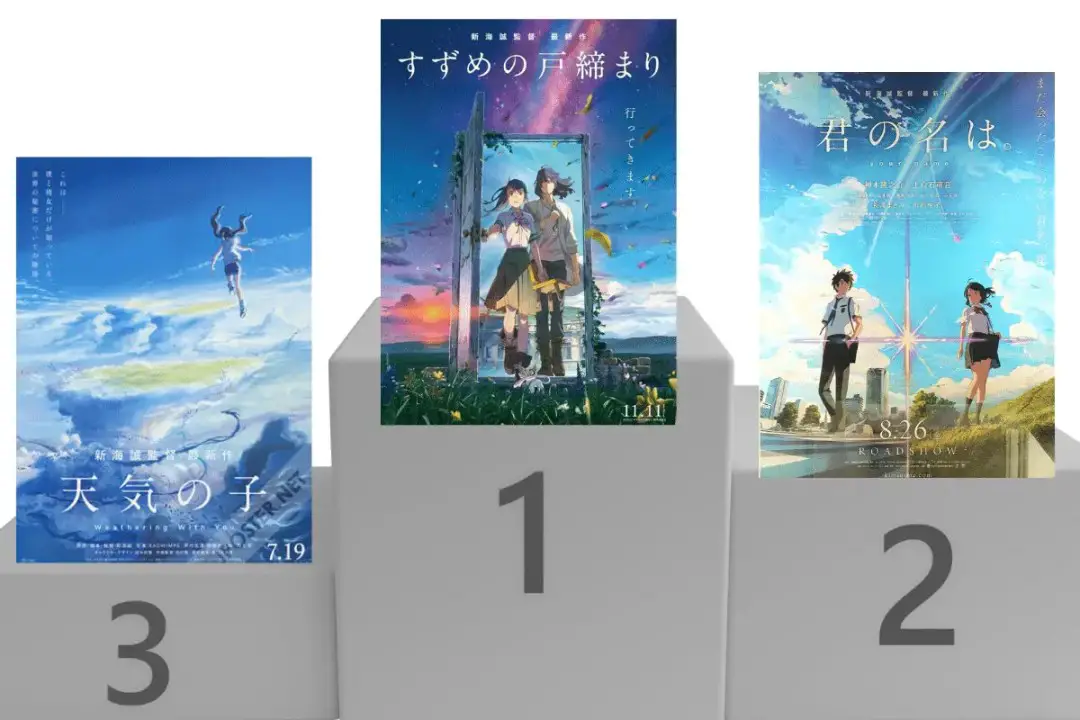
This was extremely well-written with wonderful insights, Limarc! I really enjoyed how you insert a bit of Japanese culture into your review, and explaining the theme of the story. It certainly made me realised the layer of storytelling that Makoto Shinkai employed. Kudos to your well-crafted review! Thanks for making it! X)
Also, Suzume and Sota’s voice actors are almost how I imagine them to be, I suspect they altered the characters with some similarities to their voice actors XD
Wow thank you so much for your kind words, Ethan! I love Shinkai works so I try extra hard when reviewing them for the English speakers before the films come out overseas. Thanks for readin